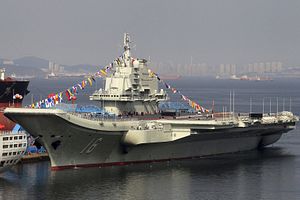The People’s Liberation Army Navy’s (PLAN) first aircraft carrier is ready for combat operations, Chinese state media claimed on November 15. According to the political commissar of the 60,000-ton Liaoning, a Soviet-era Admiral Kuznetsov-class multirole aircraft carrier, the ship “is constantly prepared for war,” the state-owned Global Times reports.
“As a military force, we are always prepared for war and our combat capacity also needs to be tested by war,” Li Dongyou, the political commissar aboard the Liaoning, said. “At this moment, we are doing our best to promote our strength and use it to prevent war, and are prepared for actual combat at any time.” According to the Global Times, the aircraft carrier has formally been described as “having a real combat capacity.”
The Liaoning was originally built as a “heavy aircraft-carrying cruiser” for the Soviet Navy, but construction of the carrier was left unfinished due to the collapse of the Soviet shipbuilding industry in the early 1990s. China purchased the unfinished hull of the Admiral Kuznetsov-class carrier from Ukraine in 1998. Once in China, the carrier underwent substantial modernization and was eventually commissioned in 2012. Ever since then, the carrier has officially been classified a training ship and continues to serve as a test platform for PLAN carrier-based naval aviation.
The Liaoning can accommodate an air wing of 24 Shenyang J-15 multirole fighter jets, a variant of fourth-generation Sukhoi Su-33 twin-engines air superiority fighters, and up to ten rotary wing aircraft including Changshe Z-18, Ka-31, and Harbin Z-9 helicopters. The PLAN certified its first air wing of domestically trained J-15 pilots in 2015. The U.S. Department of Defense estimated that the first air wing will deploy on the new carrier in 2016. It is likely that the political commissar was referring to this when declaring the ship ready for combat.
The carrier is fitted with an underpowered aircraft -launching system, a so-called ski-jump assisted Short Take-Off But Arrested Recovery (STOBAR) launch system, for fighter jets aboard the carrier. As a consequence, according to the U.S. Department of Defense, Chinese J-15 fighter jets taking off from the Liaoning are “limited in range and armament when operating from the carrier, due to limits imposed by the ski-jump takeoff and arrested carrier landings.” (The carrier also runs with an inefficient power plant additionally imposing limits on the ship’s operations.)
According to the naval analyst Andrew Erickson, “analysts estimate that the maximum takeoff weight for a J-15 from the Liaoning would be limited to approximately 62,000 pounds. By comparison, the USS Ronald Reagan can launch an aircraft with a maximum takeoff weight of 100,000 pounds.” Given the STOBAR system, aircraft launched from the carrier will also have a more limited operational range due to the fact that they need to expend a considerable amount of fuel during take-off in comparison to aircraft launched with a catapult system as is the case in the U.S. Navy.
As of now, the ship is not assigned to any of the three major fleets of the PLAN.
Despite the recent announcement, it is unlikely that the carrier will be ready for high-tempo combat operations anytime soon for a number of reasons (e.g., lack of adequate pilot training, lack of escort ships, lack of operational range etc.). Nevertheless, the ship could be deployed for regional missions including humanitarian aid and disaster relief operations, training exercises and more worrisome—operations in the South China Sea to assert China’s territorial claims there.

































